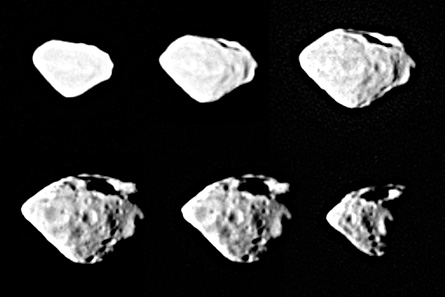On September 5, the European Space Agency’s Rosetta mission
became the first spacecraft to take a close-up portrait of a rare type of
asteroid that lies in the main belt, between the orbits of Mars and Jupiter.
The craft captured images of a 5-kilometer-wide asteroid, called 2867 Steins, while
flying within 800 kilometers of the rocky body’s surface.
Rosetta found that the grayish asteroid is shaped like a diamond, measuring
about 5.9 kilometers by 4 kilometers. “We observed a new jewel in the solar system,”
said Rosetta scientist Uwe Keller during a Sept. 6 press briefing at ESA
headquarters in Darmstadt, Germany.
A camera on Rosetta identified 23 craters bigger than 200 meters across, with
the largest crater, on the north side of Steins, measuring 2 kilometers in
diameter. The camera also spotted a chain of small craters near the rim of the
largest crater, said Keller, of the Max Planck Institute for Solar System
Research in Katlenburg-Lindau. Crater chains have also been seen on Earth’s
moon and Jupiter’s large moons and may be produced by debris excavated when
impactors slammed into the bodies and formed the large craters. The asteroid
reflects about 35 percent of the sunlight striking its cratered surface,
slightly less than scientists calculated but still brighter than most
asteroids.

Additional analysis of images and spectra recorded during
the flyby is expected over the next days to weeks.
Asteroids are rocky leftovers from the planet-building process. These chunks of
material never got incorporated into planets when they formed some 4.5 billion
years ago and therefore offer clues about the birth of the solar system.
“It’s a little like a piece of DNA from
the solar system,” says Rosetta project scientist Rita Schulz. Steins
belongs to a rare class of main-belt asteroids known as E-type, which are
distinguished by their high reflectivity and a silicate-rich composition that
includes the mineral enstatite. E-type asteroids are thought to be fragments
chipped off the outer edge of larger chunks of rock during an impact.
Spacecraft have obtained detailed images of only eight other asteroids among
the hundreds of thousands of rocks in the main asteroid belt.
The flyby and a scheduled visit to another asteroid, 21 Lutetia, in 2010, are
mere stopovers en route to the craft’s main mission. In 2014, Rosetta will
rendezvous with the comet 67P/Churyumov-Gerasimenko, releasing a small lander
onto the comet’s icy surface when it is far from the sun and inactive. Then, for
the next two years, Rosetta will chase the comet and lander as they head toward
the inner solar system at speeds of over 100,000 kilometers per hour. Rosetta
will observe the changes in the comet as it nears the sun’s warming rays. The
sun’s heat causes ice on the comet to suddenly and violently evaporate. Jets of
gas blasted from the comet’s surface drag out dust grains along with it,
forming the coma, or tail.







